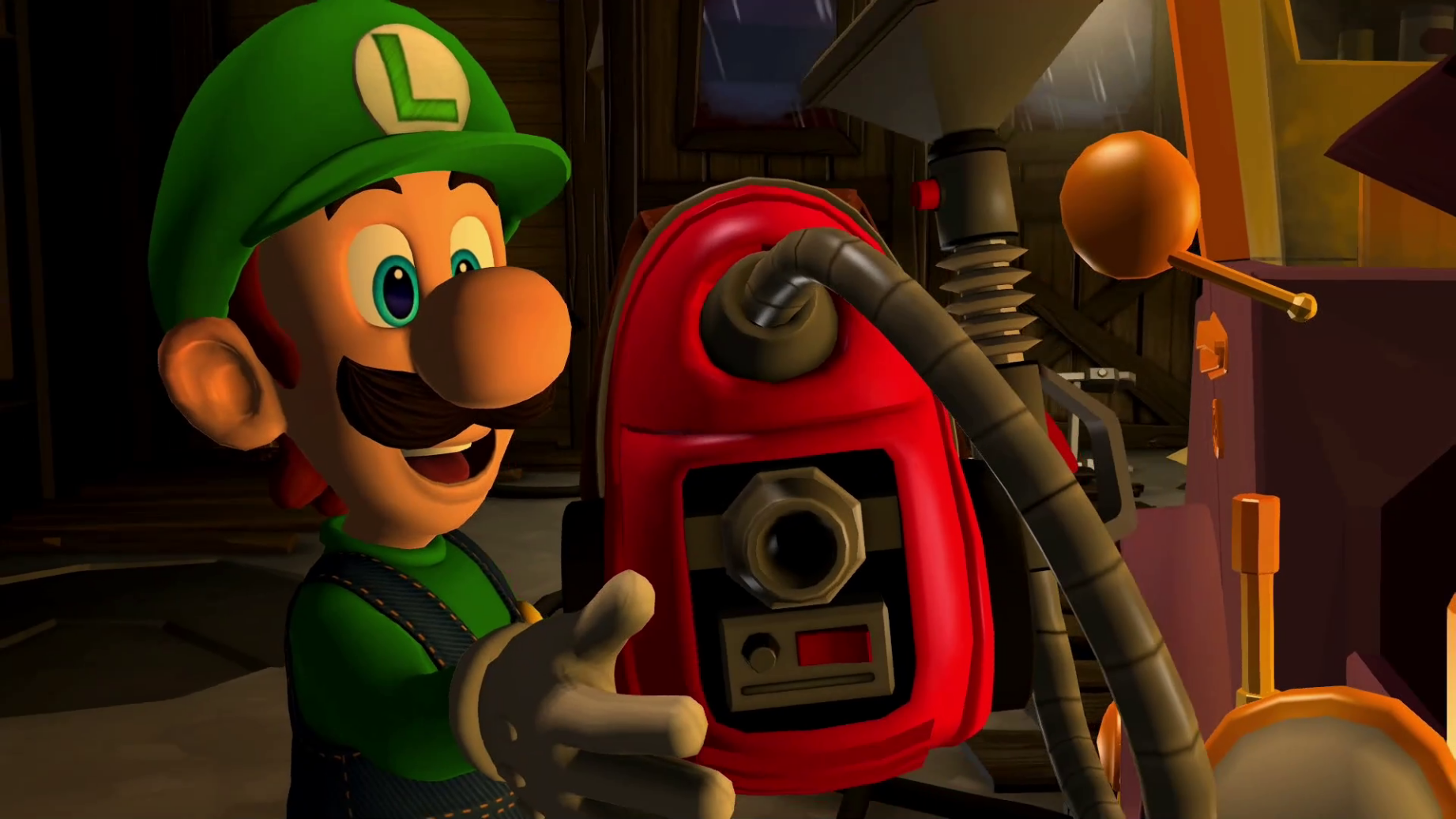As the Switch moves into the twilight years of an especially lengthy lifespan, Nintendo has increasingly turned toward remasters of its back catalog to fill out the release calendar. This is the context for Luigi’s Mansion 2 HD, a remastered version of a relatively recent 2013 release on 3DS. The sequel is a game that served as a sharpened, refined take on the ideas presented by the first Luigi’s Mansion–and laid the groundwork for the even better Luigi’s Mansion 3–so having access to that piece of the series’ history untethered from the 3DS makes it feel that much more valuable. While the recency makes it feel less essential than some remasters of older classics like Metroid Prime or Super Mario RPG, it’s still just as fun to solve puzzles, schlurp ghosts into your jerry-rigged vacuum cleaner, and enjoy some gentle scares along the way.
The original Luigi’s Mansion was a cute diversion-verging-on-tech-demo that helped cement Luigi’s personality as Mario’s skittish and reluctantly heroic brother. Drafted against his will to catch a bunch of ghosts, it was a kid-friendly take on Resident Evil by way of Ghostbusters–even down to the tank controls, puzzles, and interconnected mansion setting. Luigi’s Mansion 2, by comparison, swaps out the single environment for a series of different buildings that all reside in one extremely haunted neighborhood called Evershade Valley. That gives the game a more disconnected, mission-based feeling than both its earlier and later entries, in exchange for environments that present very differently from each other and allow for the feeling of themed haunted houses: an ancient tomb, a creaky old snow lodge, and so on.
The mission structure focused on single goals that take around 15-20 minutes to complete seems primed for portable play on 3DS–the game’s original platform–and that gives Luigi’s Mansion 2 a particular rhythm. It’s easy to pick up and digest a stage or two at a time but harder to get lost in for long stretches of time without feeling like you’re going through the same steps over and over. A typical mission has you exploring a particular section of the building you’re investigating, usually needing to locate some MacGuffin to unlock a section, sucking up a few scattered ghosts, and taking part in at least one arena-style fight against several ghosts. Rinse, repeat.
Luigi progressively gains access to three key pieces of equipment: the Poltergust, the Strobulb, and the Dark-Light Device. Nintendo games excel at filling their worlds with playful touches, and these tools are key to making the environment feel alive. Your Poltergust is mostly used for eliminating ghosts, but it can also suck up money, pull off fake wallpaper to reveal hidden passageways, spin fans, or impact the environment in a few other ways. The Strobulb stuns ghosts but also activates electronic buttons and switches. And the Dark-Light Device is mostly used to fish keys and other objects out of haunted paintings, but later is used for activities like tracking footprints from a ghostly “Polterpup” dog. Each of these pieces of gear also upgrades to be stronger and faster, but that progression is linear and you don’t have any real control over which gear to prioritize. Still, as long as you’re doing a little exploration you’ll keep pace with the upgrades you need.
The tank controls can take some getting used to, especially as ghosts circle around a corner and you need to rotate Luigi’s body to point the Poltergust or Strobulb at them. The right stick controls the direction your tool is pointing, while the Poltergust, Strobulb, and Dark-Light Device are mapped to ZR, R, and L, respectively. You can freely point your tools with the right-stick, which makes the “look up” function of the X button an odd vestigial piece of the original 3DS controls. In addition to the standard tank controls, listed as Omnidirectional, there’s a Horizontal option for movement that feels a little more natural, but it can still be difficult to get your bearings quickly.
The 3DS origins have other odd holdovers as well. The overhead shots of each environment while selecting a mission look uniformly low-quality, which sticks out. Occasionally, objects will appear surprisingly jagged in ways that look unintentional despite the series’ more spooky, angular aesthetic. Not all of the anachronistic artifacts are uninvited, though; Luigi communicates with a “Dual Scream” device, which is clearly just a clunky old first-gen Nintendo DS. It was already a silly visual gag in the original, but this many years removed, it’s downright nostalgic.
Luigi’s Mansion 2 HD also still showcases a sparkling sense of personality and humor, especially with Luigi’s animations. It’s clear he’s been roped into this ghost-catching gig against his will, and he doesn’t really want to do it, but Professor E. Gadd barrels through his apparent objections. The ghosts themselves are often funny, too, engaging in slapstick antics, especially when you spy on them through a peephole or a crack in the wall. At one point, I peeked into a room and laughed to find that I was peering over a ghost’s shoulder as he hovered over a toilet reading a newspaper.
Speaking of Professor E. Gadd, I really can’t stand his design. This isn’t the fault of Luigi’s Mansion 2 HD specifically–he looks largely the same as he did in the original and Luigi’s Mansion 3. But it’s just hard to look at a classic, iconic design like Luigi or a Boo next to this obnoxiously ugly design, which looks like a mad scientist crossed with a baby. Nintendo seems unfortunately married to E. Gadd as the impetus for Luigi’s ghostly adventures, but that character’s look has aged terribly.
The vast majority of Luigi’s Mansion 2 is fairly simple, with a good sense of pacing between solving basic puzzles and catching a few ghosts. I would only occasionally feel stumped when a puzzle solution wasn’t apparent, but the game is usually reliable about at least pointing you in the right direction of which room you should be exploring next.
Despite that, though, the combat difficulty ramps up severely at the end, especially in one particular stage that is a long gauntlet of enemy encounters. The combination of ghosts who are shielded against you in various ways, and others that surprise you and temporarily remove control, makes it much harder to manage. At this point more than any other, I keenly felt the lack of checkpoints. Since Luigi’s Mansion 2 is designed around quick, digestible missions, checkpoints are basically non-existent–if you fail out a mission, you simply restart it from the beginning. Most of the time this is fine, but it feels much less fine when you’re 95% done with a late-game mission and then fail out and need to start all over again.
Like the 3DS version, the single-player campaign is augmented by the multiplayer Scarescraper mode, a series of randomized challenges that can be played through the Switch Online service. Up to four players can explore the map together from a handful of modes. Hunter Mode has you trying to eliminate a series of ghosts, for example, while Polterpup Mode has you tracking the pawprints of a roaming Polterpup to proceed.

Despite being created for multiplayer, though, most of the time your best bet is splitting up and covering different rooms separately, so it doesn’t feel all that different than a regular play session–just with randomized rooms that fit together like Lego pieces. Teamwork and coordination are a must for the post-match challenge, though, as Red Coins get scattered throughout the map and the timer is way too short to reasonably get them all yourself. Gathering all the Red Coins gets your team a post-stage bonus, so if you want to maximize your ghost-hunting abilities, the divide-and-conquer approach is essential. The power-ups are randomly doled out to a single player at a time, though, so one player may get better gear than the rest, and there doesn’t appear to be any catch-up mechanism for players who miss out.
You can take on these challenges in multiples of five, up to 25 stages at a time, and then completing those will unlock Endless mode. You could technically complete these missions with only one player, but it would be much harder and you almost certainly would miss out on power-ups, so it would probably get unreasonably difficult very fast. You can also take the coins earned in Scarescraper back into the single-player mode for upgrades. However, in a limited play session, I only earned 50 gold for a five-floor challenge, regardless of how much loot I actually collected. Given that the higher-end single-player upgrades end up costing tens of thousands of coins, you can’t realistically expect to grind them out with the multiplayer mode. So the Scarescraper exists mostly just to have fun with your friends, not to make real game progression. To that end, it’s low-impact and breezy, but unlikely to last more than a few play sessions.
Luigi’s Mansion: Dark Moon on 3DS was a surprising revival for an unconventional game. Now that we’ve had Luigi’s Mansion 3, the series has come more into its own, and the second game is neither the trailblazer nor the refined third entry. That makes Luigi’s Mansion 2 HD an oddball–less essential than some other Switch remakes, but an interesting middle step in the development of Luigi’s puzzle series, with its own charms and place in the series history.






